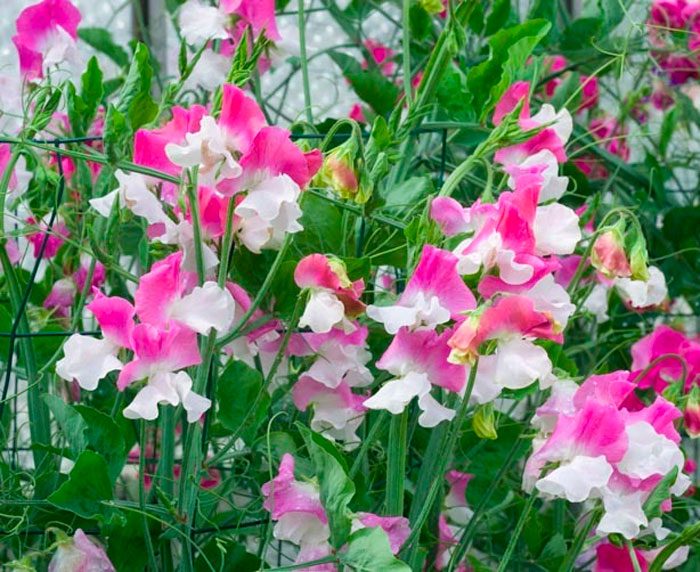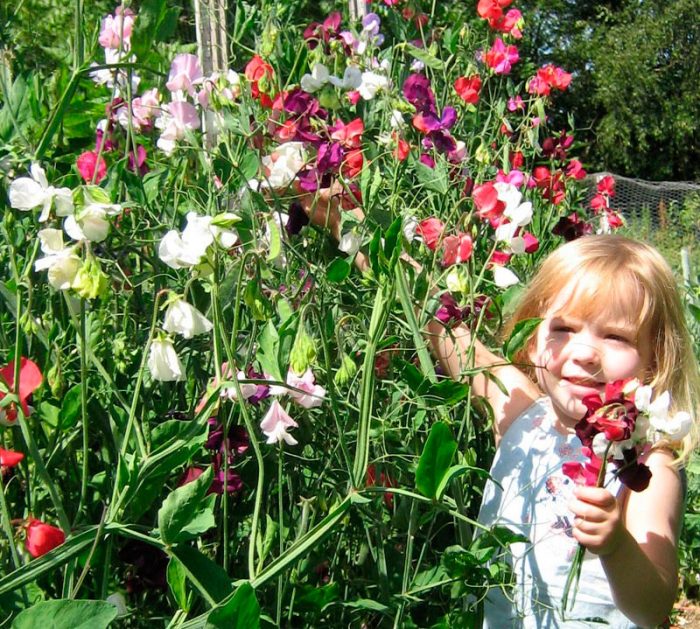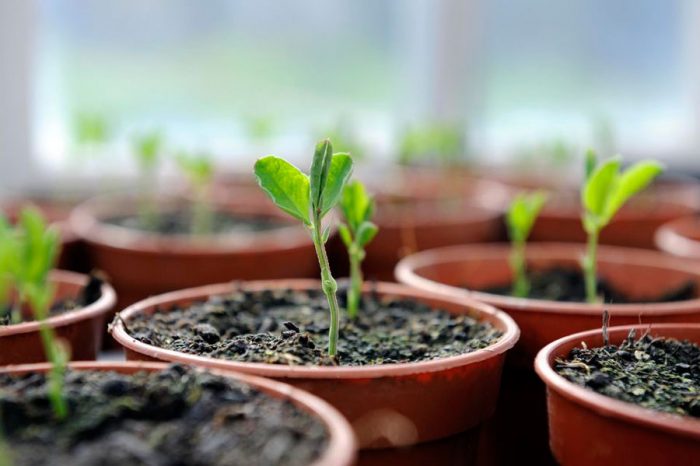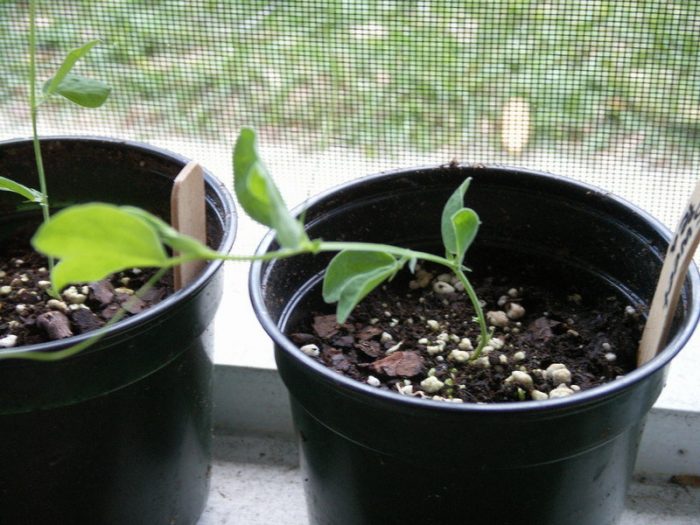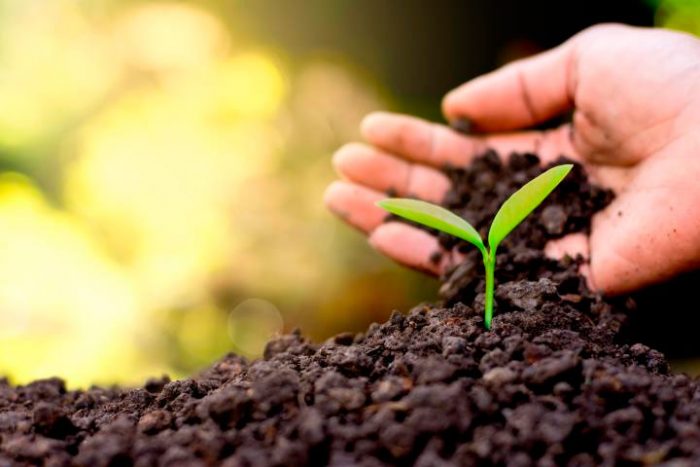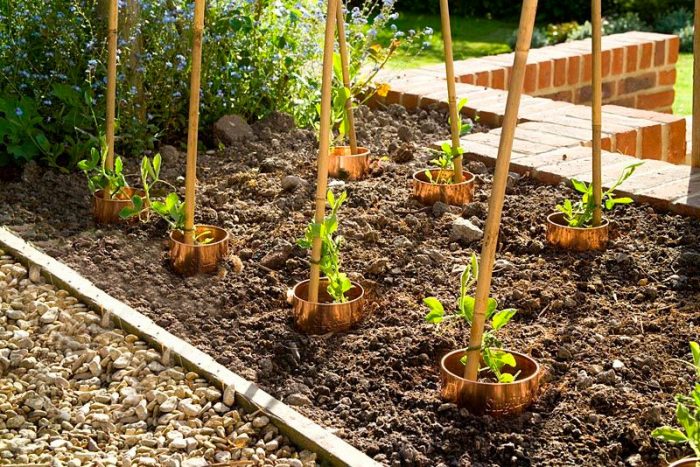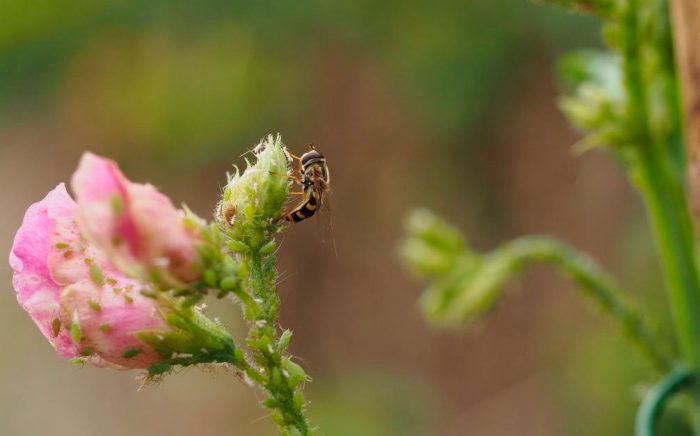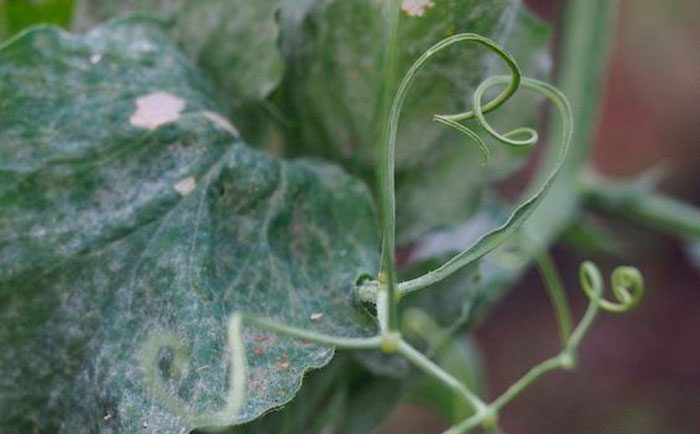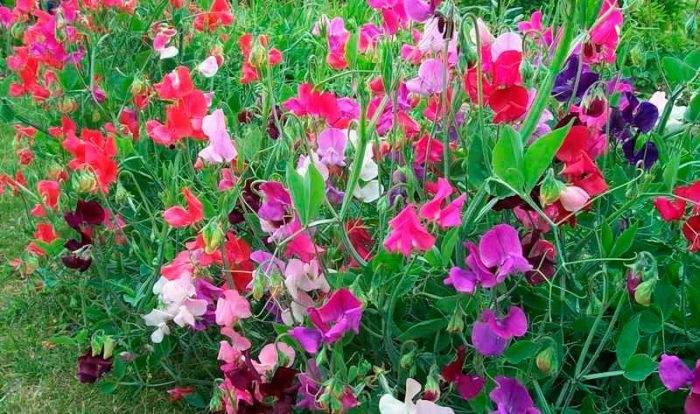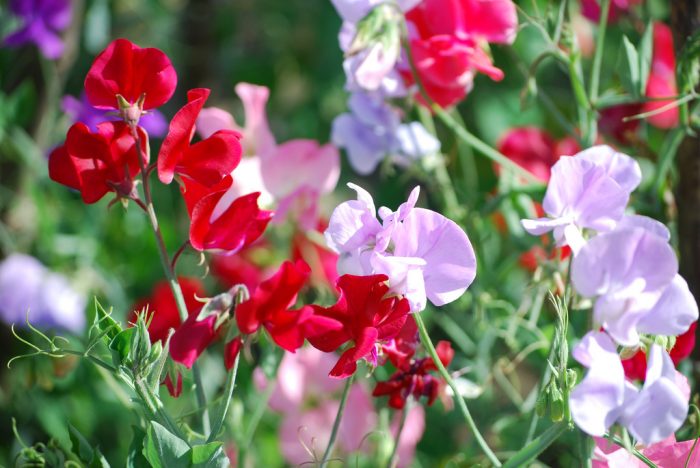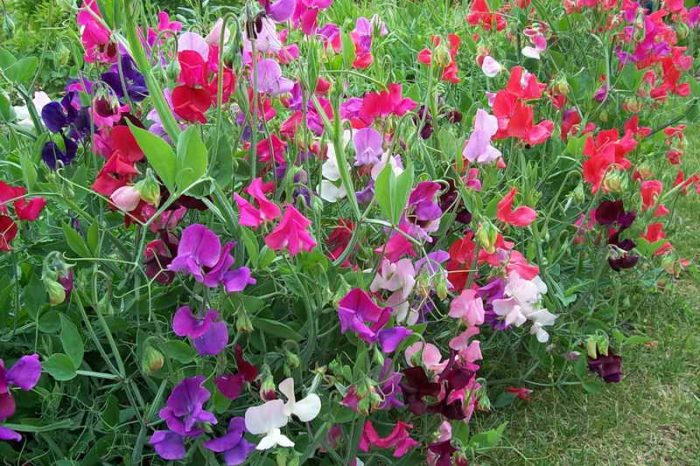Sweet pea (Lathyrus odoratus) is a member of the China genus of the Legume family. The scientific name includes 2 words, the first in translation means "very attractive", and the second - "fragrant". Some scientists are confident that the homeland of this herbaceous flowering plant is the Eastern Mediterranean. From Sicily, its habitat extends east to the island of Crete. Another part of experts believe that sweet peas were brought to Sicily by conquistadors from Peru, as well as Ecuador. Such a flower has been cultivated since the 18th century. F. Kupani, who was a Sicilian monk, in 1699, passing under the walls of the monastery, saw a very fragrant flower, he sent its seeds to his friend, a school teacher in England. Later, thanks to English breeders, this plant became the king of ampels. Already in 1800, the first 5 varieties appeared. Today there are more than 1 thousand different varieties of sweet peas. Gardeners appreciate very effective flowers in it, as well as an incredibly pleasant aroma, which is reflected in the name of the plant. It is often used for vertical landscaping of balconies, gazebos and terraces. Sweet pea is a perennial, but in the middle latitudes it is cultivated as an annual.
Content
Features of sweet peas
For the first time, sweet peas, or a fragrant rank, were described by K. Linnaeus, and this happened in 1753. The rod highly branched root system of this flower penetrates deep enough into the ground (up to 150 cm). The fragrant rank, like most legumes, differs in that it enters into symbiosis with nodule bacteria, which assimilate nitrogen from the air. Climbing weakly branched shoots. The plant can climb up the support, while it clings to it with branched tendrils (modified leaf plates). The flowers are similar in shape to moths, but the British claim that they look like a boat with a sail: the corolla includes a large petal, which is similar to a wide-oval sail, 2 side petals, which are oars, and a pair of lower fused petals, which are boat. Such a plant blooms very magnificently. Flowering begins in July, and if the sweet pea is properly cared for, it will last until frost.The fruits are small bivalve beans, inside of which there are 5 to 8 spherical seeds squeezed from the sides, painted in light green, yellow or brownish-black. They remain viable for 6–8 years.
Growing sweet peas from seeds
Sowing
Sowing seeds of sweet peas for seedlings is carried out in mid-March. Seeds germinate rather poorly, so they must be prepared before sowing. To do this, they are immersed in water for 10-12 hours, or they can be kept in the Bud solution for some time (for 1 liter of water from 1 to 2 grams), while its temperature should be 50 degrees. After that, they are placed in moistened sand, sawdust or gauze for germination, where they must stay at a temperature of 20 to 24 degrees for 2–4 days. As soon as the seeds are baked. they must be sown immediately. For sowing seedlings, it is recommended to use a ready-made soil mixture Rose or Saintpaulia, and you can also use a soil mixture consisting of peat, humus and turf soil (2: 2: 1). Whichever soil mixture you choose, it must be disinfected with a strong solution of potassium manganese. For sowing seeds, use pots or cups. It is necessary to sow seeds in a moist soil mixture. 2 or 3 seeds are placed in one container, they are buried in the soil mixture by 20-30 mm, no more. If sowing is done in a common box, then a distance of 80 mm should be maintained between the seeds. After the crops are watered, the containers must be covered with foil from above, then they are removed on a well-lit windowsill in a warm place (from 18 to 22 degrees).
Growing seedlings
After the seedlings begin to appear en masse, as a rule, this happens 7-15 days after sowing, it is necessary to remove the shelter from the containers, and they are also rearranged to a cooler place (from 15 to 16 degrees), thanks to which nodules will form on the roots, which fix nitrogen. The soil should always be slightly damp. It is recommended to put the seedlings on the southern windowsill, if this is not possible, then the plants should be provided with artificial lighting for 2 to 3 hours every day. Experienced gardeners recommend taking a fluorescent lamp or phytolamp for this, which should be fixed at a height of 0.25 m above the seedlings. You can turn on such a lamp, for example, from 7 to 10 or from 17 to 20 hours. To stimulate the growth of lateral shoots during the formation of the second or third true leaf plate, the seedlings should be pinched. Then the seedlings need to be fed, for this they use Kemira's solution (2 grams per 1 liter of water).


Watch this video on YouTube
Planting sweet peas in the ground
What time to plant
The planting of sweet pea seedlings in open soil is carried out in the last days of May, after the soil warms up well, and return spring frosts are left behind. If the planted plants already have buds or flowers. they should all be removed, since after planting they must spend all their strength on the formation of the root system.
1.5 weeks before transplanting the seedlings into the garden, you need to start hardening. To do this, the plant is transferred to fresh air every day, the duration of this procedure should be increased gradually until the sweet peas can be outside around the clock.
Landing features
The planting site should be sunny and well heated. The soil suitable for this plant should be moist, saturated with fertilizers, well-drained, while its acidity is 7.0–7.5.
Before planting, the site must be prepared. To do this, they dig it to the depth of a shovel bayonet, while humus or compost, as well as potash and phosphorus fertilizers, must be added to the soil. It is impossible to fertilize such a flower with fresh manure, since it can cause fusarium wilt.It should also be noted that peas do not need nitrogen fertilizers.
Prepare the holes for planting, the distance between them should be about 0.25 m.In 1 hole, 2 or 3 bushes should be planted at once. If tall sweet peas are planted, then immediately after planting, supports must be installed near the bushes. Since this plant is grown in middle latitudes as an annual, in the autumn, plant residues are destroyed, while peas can be planted on this site only after 4 or 5 years.
Sweet pea care
Growing sweet peas in your garden is a snap. Such a plant just needs to be watered, weeded, fed, tied to a support, loosened up the surface of the site, and also protected from pests and diseases.
It is necessary to water the flower systematically, while using a sufficient amount of water. Lack of moisture can cause buds and flowers to fall off and can significantly shorten flowering times. In dry summer months, when there is a minimum amount of rain, watering should be done once every 7 days, and about 3–3.5 buckets of water should go per square meter. In order for the flowering to last longer, it is necessary to pick off the flowers almost immediately after they begin to wilt.
Sweet peas, which are tall varieties, need support (net or twine). As the shoots grow, they should be directed to the most suitable side, after which they are tied.
To stimulate the growth of adventitious roots, it is necessary to spud the bushes to a height of 50 to 70 mm, while nutrient soil must be added to the base of the stem.
Such a flower can do without fertilizing, but experts still recommend them. At the very beginning of the growing season, the plant must be fed with the following nutrient mixture: 1 large spoonful of urea and Nitrofoska are taken for 1 bucket of water. When the peas just bloom, they will need to be fed with a solution consisting of 1 bucket of water, in which 1 large spoonful of potassium sulfate and Agricola are dissolved. And during the period of active flowering, fertilizing with Rossa and Agricola is made for flowering plants (for 10 liters of water, 1 large spoon of each fertilizer).
You do not need to cut this plant.
Diseases and pests
Sweet peas can be seriously damaged by various types of aphids and root weevils. At the very beginning of the growing season, the weevil gnaws semicircles along the edge of the leaf plates. Moreover, its larvae damage the root system, nibbling it. For prophylactic purposes from a weevil during planting seedlings in open ground, it is necessary to pour 100 milligrams of Chlorophos solution (0.1%) into the prepared holes. The bushes themselves must be treated with the same solution.
Such types of aphids can settle on a fragrant pot as: rank, bean and pea. These sucking insects feed on the sap of the plant, as a result of which its organs undergo deformation. They are also carriers of dangerous viral diseases. To destroy such a pest, as well as for preventive purposes, the bushes must be sprayed with Tsiram or Tsineb 2 or 3 times during the growing season, while the break between treatments should be 15–20 days.
Sweet peas are susceptible to diseases such as ascochitis, powdery mildew, peronosporosis, fusarium, root rot, black leg, viral mosaic and deforming viral mosaic of peas.
If brown spots have formed on the surface of the beans, leaf plates and shoots, which have pronounced borders, this means that the bush is affected by ascochitis. It must be sprayed 2 or 3 times with Rogor's solution, while the distance between treatments should be 15–20 days.
In the second half of the summer period, the bushes can become infected with powdery mildew or downy mildew (peronosporosis).In affected plants, a loose whitish bloom forms on the surface of shoots and foliage. As the disease progresses, the yellowing of the leaf plates occurs, then they become brown and fly around. To eliminate pathogens, the foliage should be washed with a solution of colloidal sulfur (5%).
If the foliage has begun to turn yellow and wither, then this indicates that the plant is affected by fusarium. This disease is considered incurable, therefore, diseased bushes must be removed from the soil and destroyed, and those plants that remain must be sprayed with a solution of TMDT. For preventive purposes, it is recommended to observe crop rotation.
If a bush is affected by root rot or a black leg, then its roots and root collar become dark, and then the plant dies. Affected bushes cannot be cured, so they should be dug up and burned. It is necessary to transplant the remaining healthy specimens, while it is necessary to disinfect the root system of flowers and soil.
When a viral mosaic is affected, a line pattern is formed on the surface of the leaf plates, the upper parts of the affected stems become twisted and deformed. Viral diseases are currently not treated, in this regard, diseased bushes must be dug up and destroyed.
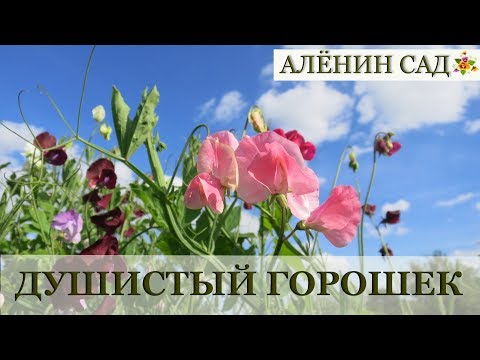

Watch this video on YouTube
Types and varieties of sweet peas with names
Sweet peas have a large number of varieties, more precisely, more than 1 thousand. All varieties are divided into 10 garden groups, and the following are the most popular:
- Duplex... This flower has powerful shoots. The inflorescences consist of 4 or 5 flowers with a double sail. This variety is among the best in its group.
- Cream... The height of the bush is about 0.9 m. The diameter of the fragrant pale cream flowers is about 45 mm, they have a double or folded sail. The height of the straight peduncles is about 0.2 m, they have inflorescences consisting of 3 or 4 flowers.
- Galaxy... This group of late-flowering varieties was created in 1959. The height of the bush is more than 200 cm. Powerful inflorescences reach 0.3–0.5 m in length. They include 5–8 often double corrugated flowers reaching about 50 mm in diameter. Such plants are recommended to be used for cutting or for landscaping.
The best varieties:
- Neptune... The height of the branchy bush is about 150 centimeters. Powerful straight peduncles reach 0.3 m in height, inflorescences are placed on them, consisting of 5-7 blue flowers, which reach 50 mm in diameter, they have a white base and most often a double sail.
- Milky Way... The height of the branchy bush is about 1.45 m. The flowers have a delicate cream color and have a strong odor and a double sail, they reach 50 mm in diameter. Inflorescences consist of 5 or 6 flowers.
- Bijou... This group of semi-dwarf late-flowering varieties was created in 1963 by specialists from America. The bush reaches a height of about 0.45 m. The length of powerful inflorescences is about 0.3 m, they include 4 or 5 pieces of corrugated flowers, which reach about 40 mm in diameter. These bushes do not need support. They are recommended for use on curbs and ridges.
Spencer Group
It includes strong multi-stem plants, which reach a height of about 200 cm. The brushes include 3 or 4 corrugated flowers, which can be double or simple. They have wavy petals and reach 50 mm in diameter. This group contains medium-flowering varieties that are recommended for cutting and landscaping. The best varieties include the following:
- Warrier... On straight peduncles there are flowers of a dark purple color, at the base of the boat they have white strokes. In diameter, the flowers reach 40 mm, their oars are bent, and the sail is wavy.
- Jumbo... The height of the bush is about 1 m. The pink-salmon flowers have a slightly wavy sail, a white boat and slightly bent oars.The smell of the flowers is not very strong, and they reach 40 mm in diameter. Peduncles are powerful and straight.
- Charlotte... The height of the bush is about one and a half meters. The rich crimson flowers reach 45 mm in diameter, their oars are widely spaced, and the sail is wavy. The inflorescences contain from 2 to 4 fragrant flowers. The height of powerful peduncles is about 0.25 m.
- Cream Gigantic... The height of the bush is about 1.75 m. Large cream-colored flowers have a strong odor and reach 45 mm in diameter. Their sail is wavy, and slightly bent oars are widely spaced. The inflorescences contain from 3 to 4 flowers. The height of the peduncles is about 0.3 m.
The following varieties of the group are also quite popular: Spencer Monty, Mahogany, Flagship, King Lavender, Iyer Warden, Garnet, etc.
Earley Spencer
This group of early flowering varieties was created in 1910 by American specialists. The height of the bushes is from 1.2 to 1.5 m. The length of the inflorescences is about 0.35 m, they include 3 or 4 pieces of corrugated flowers, reaching 45 mm in diameter. These varieties are suitable for cutting and landscaping.
Cupid
This group of low-growing varieties appeared in 1895. The height of the bushes is about 0.3 m. The length of the inflorescences is about 70 mm, they consist of 2 or 3 small flowers, which can be painted in a variety of colors. Such plants are suitable for landscaping.
Cuthbertson-Floribunda
This group was born in America in 1952. The height of a tall bush is about 200 cm, and the length of powerful inflorescences is about 0.4 m. They consist of 5 or 6 corrugated large flowers, reaching 50 mm in diameter. These early flowering varieties are used for cutting. The best varieties:
- David... The height of the bush is about 1.4 m. Fragrant large flowers of dark crimson color at the base of the boat have a white smear, and their sail is wavy. The length of rigid peduncles is about 0.3 m, at their top there are inflorescences, which include 5 or 6 flowers, reaching 50 mm in diameter.
- Kenneth... The height of the bush is 100 cm. The inflorescences consist of 5 or 6 large flowers of dark red color. In diameter, the flowers reach 40 mm, their oars are slightly bent, and the sail is slightly corrugated. The length of the peduncles is about 16 centimeters.
- White Pearl... The length of the peduncles is about 0.3 m, they have inflorescences that consist of 5 or 6 white flowers, reaching 45 mm in diameter.
The following varieties of the group are also quite popular: Zhelanny, Peggy, Robert Blen, William, etc.
Royal Family
This group was born in 1964, it included heat-resistant varieties. These varieties are considered to be improved varieties of the Cuthbertson-Floribunda group. The length of the inflorescences is about 0.3 m, they include large double flowers of various colors (depending on the variety). This group has one big drawback: such plants are overly sensitive to the length of daylight hours. In this regard, they cannot be grown in the winter. Such plants are suitable for cutting and landscaping.
Multiflora Gigantea
This group includes early flowering varieties, she was born in 1960 in America. The height of the bushes is about 250 cm. The length of powerful inflorescences is 0.35–0.5 m, they include from 5 to 12 corrugated flowers, reaching about 50 mm in diameter. The varieties are suitable for cutting and gardening.
Ruffled
The group included plants with sturdy stems. One inflorescence contains from 6 to 10 large flowers. The plants have powerful and long peduncles. The sail is wavy. The best varieties:
- Grace... The height of the branchy bush is about 1.55 m. The inflorescences include 5–7 fragrant flowers of a delicate lilac color with dark veins, which reach 50 mm in diameter. The sail is wavy. Hard peduncles are about 0.35 m high.
- Ramona... The height of the bush is about 1.3 m. The color of the flowers is rich carmine, the sail is wavy, and at the base of the boat there is a white tongue. The length of the rigid peduncle is 0.3 m. One inflorescence contains 5 or 6 flowers, reaching 50 mm in diameter.
Intergen
This group of low-growing early flowering varieties was born in 1991 thanks to Russian specialists. This group was able to fill the niche between the varieties of the Cupido and Bijou groups. The height of the bushes is 0.35–0.65 m, they do not need supports. The length of the inflorescences is about 0.2 m, they include 3 or 4 simple flowers, reaching 30 mm in diameter. The best variety is Geniana: the height of the bush is 0.3–0.5 m, the lilac-white flowers have a strong odor.
Lel
This group was born in 1991. It is intermediate between Bijou and Multiflora Gigantea. The height of the bushes is 0.65-1 m. The length of the powerful inflorescences is about 0.3 m, they include from 7 to 12 corrugated flowers, reaching 45 mm in diameter. The best varieties:
- Lucien... The height of the bush is 0.4-0.6 m. The pinkish flowers have a strong odor.
- Lisette... The bush reaches a height of 0.4–0.6 m. The rich red flowers are very stocky.
Groups of English varieties Jet Set and German Lizers Keningspiel were born in the seventies of the 20th century. To date, breeders continue to create more and more new varieties of this plant.

